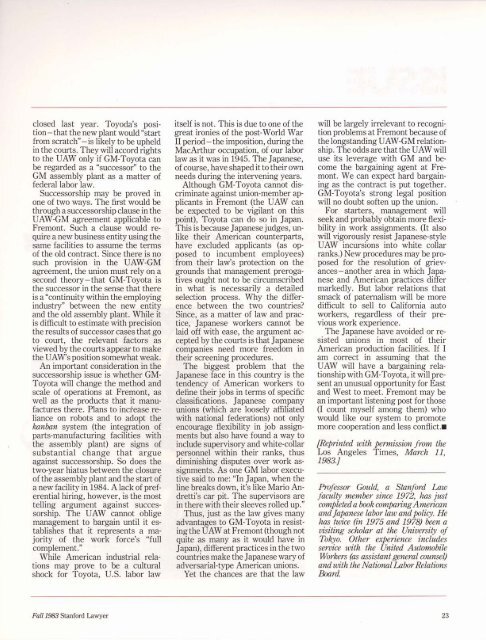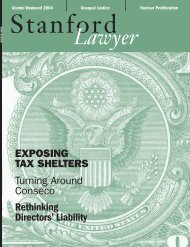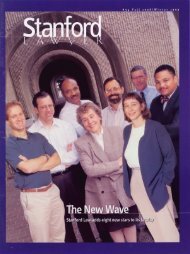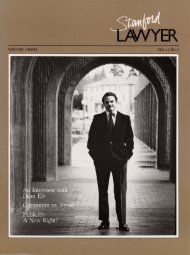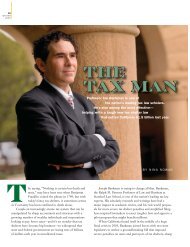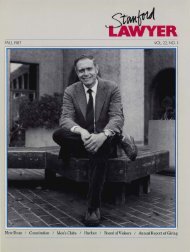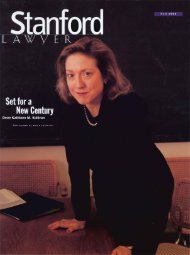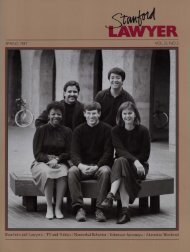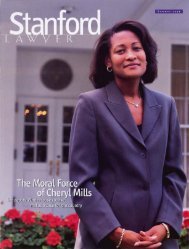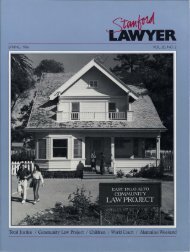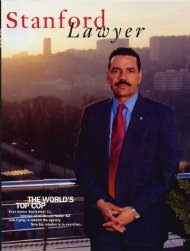Fall 1983 – Issue 30 - Stanford Lawyer - Stanford University
Fall 1983 – Issue 30 - Stanford Lawyer - Stanford University
Fall 1983 – Issue 30 - Stanford Lawyer - Stanford University
- No tags were found...
You also want an ePaper? Increase the reach of your titles
YUMPU automatically turns print PDFs into web optimized ePapers that Google loves.
closed last year. Toyoda's position- that the new plant would "startfrom scratch"- is likely to be upheldin the courts. Theywill accord rightsto the UAW only if GM-Toyota canbe regarded as a "successor" to theGM assembly plant as a matter offederal labor law.Successorship may be proved inone of two ways. The first would bethrough a successorship clause in theUAW-GM agreement applicable toFremont. Such a clause would requirea new business entity using thesame facilities to assume the termsof the old contract. Since there is nosuch provision in the UAW-GMagreement, the union must rely on asecond theory-that GM-Toyota isthe successor in the sense that thereis a "continuity within the employingindustry" between the new entityand the old assembly plant. While itis difficult to estimate with precisionthe results of successor cases that goto court, the relevant factors asviewed by the courts appear to makethe UAW's position somewhat weak.An important consideration in thesuccessorship issue is whether GMToyota will change the method andscale of operations at Fremont, aswell as the products that it manufacturesthere. Plans to increase relianceon robots and to adopt thekanban system (the integration ofparts-manufacturing facilities withthe assembly plant) are signs ofsubstantial change that argueagainst successorship. So does thetwo-year hiatus between the closureof the assembly plant and the start ofa new facility in 1984. A lack of preferentialhiring, however, is the mosttelling argument against successorship.The UAW cannot obligemanagement to bargain until it establishesthat it represents a majorityof the work force's "fullcomplement."While American industrial relationsmay prove to be a culturalshock for Toyota, U.S. labor lawitself is not. This is due to one of thegreat ironies of the post-World WarII period- the imposition, during theMacArthur occupation, of our laborlaw as it was in 1945. The Japanese,of course, have shaped it to their ownneeds during the intervening years.Although GM-Toyota cannot discriminateagainst union-member applicantsin Fremont (the UAW canbe expected to be vigilant on thispoint), Toyota can do so in Japan.This is because Japanese judges, unliketheir American counterparts,have excluded applicants (as opposedto incumbent employees)from their law's protection on thegrounds that management prerogativesought not to be circumscribedin what is necessarily a detailedselection process. Why the differencebetween the two countries?Since, as a matter of law and practice,Japanese workers cannot belaid off with ease, the argument acceptedby the courts is that Japanesecompanies need more freedom intheir screening procedures.The biggest problem that theJapanese face in this country is thetendency of American workers todefine their jobs in terms of specificclassifications. Japanese companyunions (which are loosely affiliatedwith national federations) not onlyencourage flexibility in job assignmentsbut also have found a way toinclude supervisory and white-collarpersonnel within their ranks, thusdiminishing disputes over work assignments.As one GM labor executivesaid to me: "In Japan, when theline breaks down, it's like Mario Andretti'scar pit. The supervisors arein there with their sleeves rolled up."Thus, just as the law gives manyadvantages to GM-Toyota in resistingthe UAW at Fremont (though notquite as many as it would have inJapan), different practices in the twocountries make the Japanese wary ofadversarial-type American unions.Yet the chances are that the lawwill be largely irrelevant to recognitionproblems at Fremont because ofthe longstanding UAW-GM relationship.The odds are that the UAW willuse its leverage with GM and becomethe bargaining agent at Fremont.We can expect hard bargainingas the contract is put together.GM-Toyota's strong legal positionwill no doubt soften up the union.For starters, management willseek and probably obtain more flexibilityin work assignments. (It alsowill vigorously resist Japanese-styleUAW incursions into white collarranks.) New procedures may be proposedfor the resolution of grievances-anotherarea in which Japaneseand American practices differmarkedly. But labor relations thatsmack of paternalism will be moredifficult to sell to California autoworkers, regardless of their previouswork experience.The Japanese have avoided or resistedunions in most of theirAmerican production facilities. If Iam correct in assuming that theUAW will have a bargaining relationshipwith GM-Toyota, it will presentan unusual opportunity for Eastand West to meet. Fremont may bean important listening post for those(I count myself among them) whowould like our system to promotemore cooperation and less conflict.•[Reprinted with permission from theLos Angeles Times, March 11,<strong>1983</strong>.}Professor Gould, a <strong>Stanford</strong> Lawfaculty member since 1972, has justcompleted a book comparingAmericanandJapanese labor law and policy. Hehas twice (in 1975 and 1978) been avisiting scholar at the <strong>University</strong> ofTokyo. Other experience includesservice with the United AutomobileWorkers (as assistant general counsel)and with the National LaborRelationsBoard.<strong>Fall</strong> <strong>1983</strong> <strong>Stanford</strong> <strong>Lawyer</strong>23


